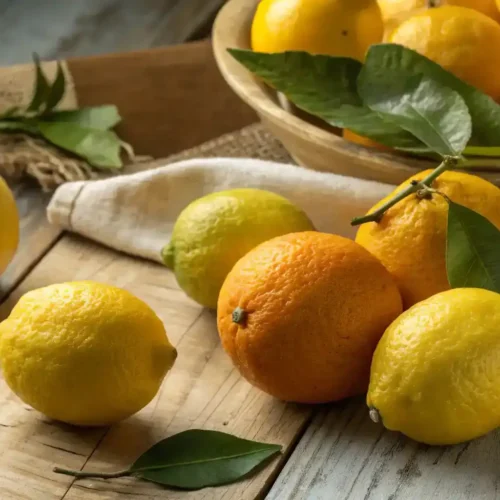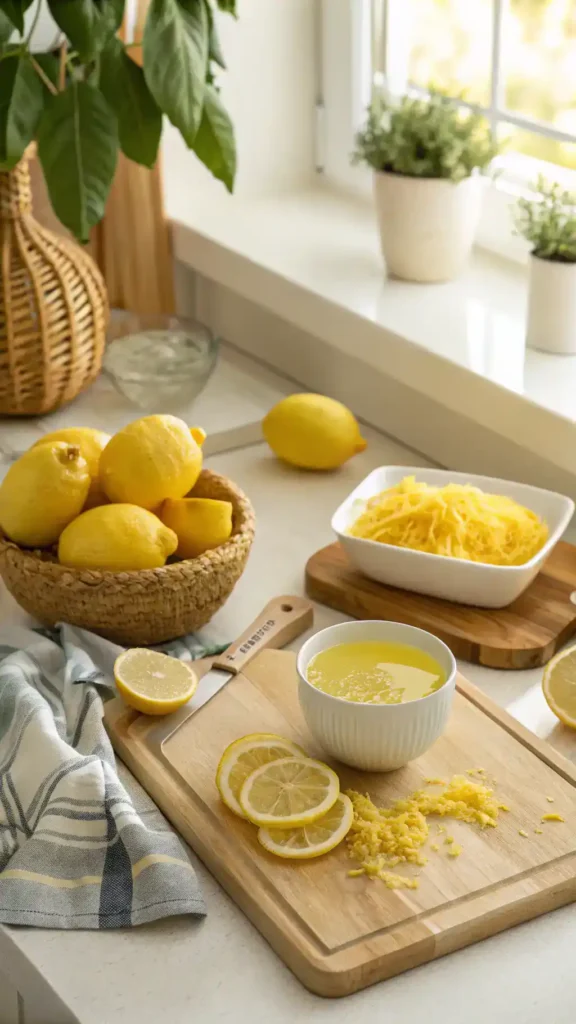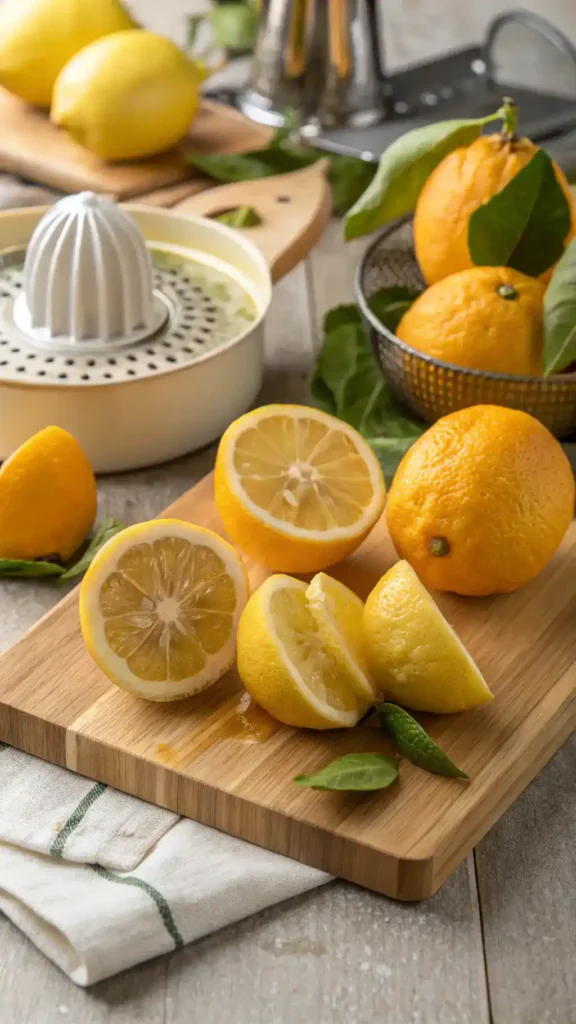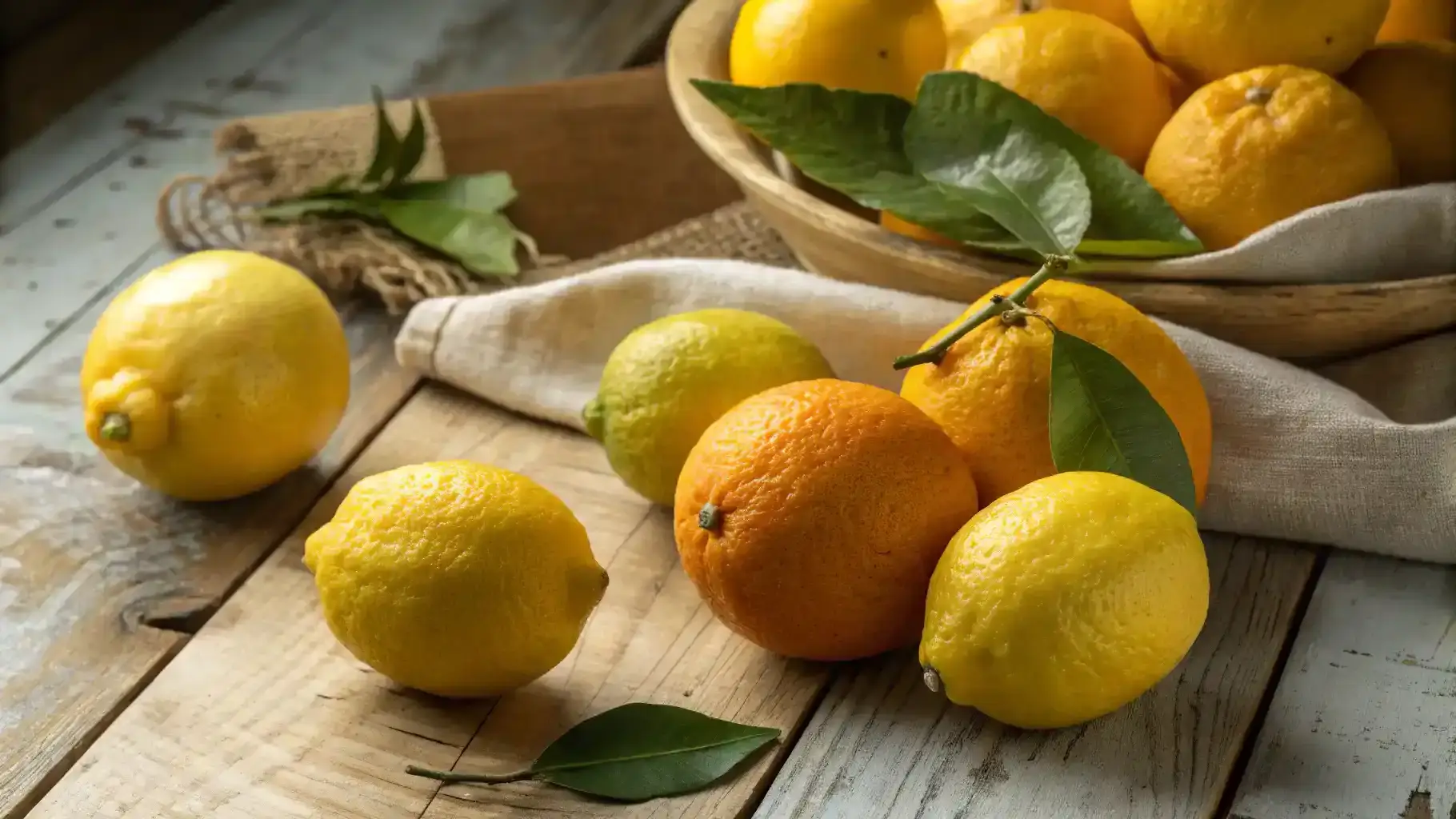Are you ready to elevate your culinary creations? Lemons are not just a zesty addition; they are a powerhouse of flavor and nutrition. With their vibrant acidity and refreshing aroma, the types of lemons available can transform your dishes from ordinary to extraordinary. Whether you are whipping up a tangy salad dressing or a luscious dessert, understanding the unique characteristics of each lemon variety can enhance your cooking experience. In this guide, we will explore the different types of lemons, their versatile uses, and how to make the most of them in your kitchen. So, let’s dive into the world of lemons and discover how they can brighten your meals!
Table of Contents
Table of Contents

types of lemons
Equipment
- 1 Microplane or Zester For zesting lemons.
- 1 Citrus Juicer For juicing lemons.
- 1 Fine-Mesh Sieve For straining juice.
- 1 Airtight Containers For storing leftover zest or juice.
Ingredients
Types of Lemons
- 2 pieces Meyer Lemons Sweeter and less acidic.
- 2 pieces Eureka Lemons Classic lemon for juicing.
- 2 pieces Lisbon Lemons Juicy and tart, great for marinades.
Organic Lemons
- 2 pieces Organic Lemons Grown without synthetic pesticides.
Instructions
Preparation
- Choose your lemons based on desired flavor profile.
Washing
- Wash lemons under cool water and dry with a towel.
Zesting
- Zest lemons using a microplane, avoiding the white pith.
Juicing
- Cut lemons in half and juice them using a citrus juicer.
Straining
- Strain juice through a fine-mesh sieve if desired.
Incorporation
- Use zest and juice in recipes as needed.
Experimentation
- Mix different types of lemons for unique flavors.
Storage
- Store leftover zest or juice in airtight containers.
Notes
| Calories | Fat | Protein | Carbs |
|---|---|---|---|
| 20 | 0g | 0g | 6g |
Key Benefits
Lemons are not just a zesty addition to your dishes; they also come with a plethora of benefits that can elevate your cooking experience. Here are the top benefits of the different types of lemons you should know:
- Nutritional Powerhouse: Lemons are rich in vitamin C, which is essential for boosting your immune system. Additionally, they contain antioxidants that help combat free radicals in your body.
- Flavor Enhancement: The acidity of lemons enhances the flavors of various dishes. Whether you’re making a salad dressing or a dessert, the right type of lemon can bring your recipe to life.
- Versatile Uses: From Meyer to Eureka lemons, each type offers unique flavor profiles. You can use them in marinades, beverages, or even as a garnish, making them incredibly versatile in the kitchen.
- Health Benefits: Lemons can aid digestion and promote hydration. Moreover, their natural detoxifying properties help cleanse your system, making them a great addition to your daily routine.
- Culinary Applications: The different types of lemons can be used in various forms, such as zest or juice. This versatility allows you to experiment with flavors and techniques, enhancing your culinary skills.
In summary, understanding the benefits of the types of lemons can significantly enhance your cooking. So, the next time you reach for a lemon, remember all the wonderful things it can do for your dishes and your health!
Love Fresh Cooking? Here’s the Types of Lemons You Should Know.
When it comes to cooking, lemons are like the little sunshine in your kitchen! Their bright, zesty flavor can elevate any dish. However, not all lemons are created equal. Let’s dive into the delightful world of lemons and explore the types of lemons you should know!
Ingredients
Here’s a fun list of the types of lemons that will brighten up your culinary adventures:
- Meyer Lemons: These beauties are a cross between a lemon and a mandarin orange. They’re sweeter and less acidic, making them perfect for desserts or salad dressings. Think of them as the gentle hug of the lemon family!
- Eureka Lemons: The classic lemon! With a bright yellow skin and a bold, tangy flavor, Eureka lemons are fantastic for juicing and zesting. They’re the go-to choice for lemonade, and they pack a punch!
- Lisbon Lemons: Similar to Eureka, Lisbon lemons are juicy and tart, but they have a thicker skin. They’re great for marinades and savory dishes. If you want a lemon that stands up to heat, Lisbon is your friend!
- Organic Lemons: Always a good choice! Organic lemons are grown without synthetic pesticides, making them a healthier option. Plus, they often have a more robust flavor, which is a win-win!

Now that you know the types of lemons, you can choose the right one for your recipe. Whether you’re zesting, juicing, or just adding a slice to your water, each type of lemon brings its own unique flair to the table. So, let’s get cooking!
How to Make Types of Lemons
Making the most out of the various types of lemons involves mastering a few essential techniques. Below, I’ll guide you through the steps to effectively utilize these citrus gems in your cooking.
- Choose Your Lemons: Start by selecting fresh lemons. Meyer lemons, Eureka lemons, and Lisbon lemons each have distinct flavor profiles. Meyer lemons are sweeter and less acidic, while Eureka and Lisbon lemons are more tart. This choice will influence your dish significantly.
- Wash the Lemons: Before using, rinse your lemons under cool water. This step is crucial because it removes any wax or pesticide residues. Afterward, dry them with a clean towel to prepare for zesting or juicing.
- Zesting the Lemons: Use a microplane or a zester to remove the outer yellow skin of the lemon. Be careful to avoid the bitter white pith underneath. Zesting Meyer lemons can add a sweet, floral note to your recipes, enhancing their overall flavor.
- Juicing the Lemons: Cut the lemons in half and use a citrus juicer or your hands to extract the juice. For maximum yield, roll the lemon on the counter before cutting it. This technique breaks down the membranes inside, allowing more juice to flow out.
- Strain the Juice: If you prefer a smooth texture, strain the juice through a fine-mesh sieve to remove seeds and pulp. This step is particularly important for dressings or cocktails where a clean finish is desired.
- Incorporate into Recipes: Now that you have your zest and juice, it’s time to get creative. Use lemon zest in baked goods for a burst of flavor or add lemon juice to dressings and marinades. For example, a simple lemon vinaigrette can elevate any salad.
- Experiment with Combinations: Don’t hesitate to mix different types of lemons in your dishes. For instance, blending the sweetness of Meyer lemons with the tartness of Eureka lemons can create a balanced flavor profile that delights the palate.
- Store Leftovers Properly: If you have leftover zest or juice, store them in airtight containers. Lemon juice can be frozen in ice cube trays for later use, while zest can be dried and kept in a spice jar. This way, you can enjoy the flavors of lemons long after they’re harvested.

By following these steps, you can fully appreciate the diverse types of lemons and their culinary applications. Each method enhances the natural acidity and brightness of lemons, making them a versatile ingredient in your kitchen.
Pro Tips, Variations, and Common Problems
When it comes to using different types of lemons, there are a few pro tips that can elevate your culinary creations. Firstly, always choose fresh lemons for the best flavor. Meyer lemons, for instance, are sweeter and less acidic, making them perfect for desserts. Conversely, Eureka and Lisbon lemons are more tart, which is ideal for savory dishes. Here are some helpful tips to keep in mind:
- Storage Tips: Store your lemons in a cool, dry place. If you want them to last longer, refrigerate them. This can help maintain their freshness for up to a month.
- Flavor Balancing: If your dish turns out too tart, consider adding a pinch of sugar or honey. This can balance the acidity of the lemons beautifully.
- Zesting Technique: Be careful not to over-zest your lemons. The white pith can be bitter, so zest only the bright yellow skin. This will ensure a vibrant flavor without the unwanted bitterness.
- Juicing Tips: To extract the most juice, roll the lemon on the counter before cutting it. This helps break down the membranes inside, making juicing easier.
- Recipe Variations: Experiment with different types of lemons in your recipes. For example, try using Meyer lemons in a lemon curd for a sweeter twist, or use Eureka lemons in a classic lemon meringue pie for that traditional tartness.
Common problems can arise when working with lemons. For instance, if your lemons seem dry or lack juice, they may be past their prime. In this case, opt for fresher lemons. Additionally, if you find your lemon juice is too acidic, adding a bit of olive oil can mellow the flavor, especially in dressings. Remember, the key to mastering the types of lemons is to understand their unique characteristics and how they can enhance your dishes.
Serving Suggestions
Lemons are not just a flavor enhancer; they are a vibrant addition to any dish. Here are some delightful serving ideas that will elevate your culinary creations using different types of lemons:
- Grilled Fish: Serve lemon wedges alongside grilled fish. The acidity of the lemon complements the richness of the fish beautifully. Additionally, squeeze fresh lemon juice over the top for an extra burst of flavor.
- Salad Dressings: Use fresh lemon juice in your salad dressings. For instance, a simple vinaigrette made with Meyer lemon juice, olive oil, and a pinch of salt can transform a basic salad into a gourmet experience.
- Baked Goods: Incorporate lemon zest into your baked goods. Whether you’re making muffins or cakes, the zest from Eureka lemons adds a refreshing aroma and flavor that is simply irresistible.
- Lemon-Infused Water: Create a refreshing beverage by infusing water with slices of Lisbon lemons. This not only looks beautiful but also provides a healthy, hydrating drink option.
- Lemon Tea: For a cozy evening, brew a cup of herbal tea and add a splash of fresh lemon juice. This is especially delightful with a hint of honey, making it a soothing drink.
- Marinades: Use lemon juice as a base for marinades. It works wonders with chicken or tofu, tenderizing the protein while infusing it with a bright flavor.
- Desserts: Finish off your meal with a lemon sorbet or lemon curd tart. The sweet and tart balance of Meyer lemons can create a refreshing dessert that leaves your guests wanting more.
In conclusion, the types of lemons you choose can significantly enhance your dishes. By experimenting with these serving suggestions, you’ll not only impress your guests but also discover new ways to enjoy the vibrant flavors of lemons in your cooking.
Preserving and Reheating
When it comes to storing types of lemons, proper techniques can significantly extend their freshness and flavor. Firstly, refrigeration is your best friend. Store fresh lemons in the crisper drawer of your fridge, ideally in a breathable bag or a mesh produce bag. This method keeps them fresh for about three to four weeks.
Alternatively, if you want to preserve them for a longer period, consider freezing. You can freeze lemon juice in ice cube trays or even slice the lemons and freeze them in an airtight container. This way, they can last up to six months without losing their vibrant flavor. Additionally, vacuum-sealing is an excellent option for maintaining quality, as it removes air and prevents spoilage. Remember, always check for any signs of mold or soft spots before using your lemons, as these can indicate spoilage or bacterial growth.
Reheating Methods
Now, let’s talk about how to reheat dishes that feature types of lemons without sacrificing their delightful taste and texture. If you’re reheating lemon-infused dishes, the oven is a fantastic choice. Preheat your oven to a low temperature, around 300°F (150°C). Place your dish in an oven-safe container, cover it with foil to retain moisture, and heat for about 10-15 minutes. This gentle method ensures that the flavors meld beautifully without drying out. Alternatively, if you’re in a hurry, the microwave can be used.
However, be cautious; heat your dish in short intervals of 30 seconds, stirring in between to distribute the heat evenly. This technique helps prevent overcooking. For an extra touch, consider adding a splash of water or a drizzle of olive oil before reheating to refresh the dish. Lastly, if you have an air fryer, it can be a quick and effective method. Set it to a low temperature and check frequently to ensure your dish remains moist and flavorful. By following these steps, you can enjoy the bright, zesty flavors of lemons in your meals, even after reheating!
Conclusion
As we wrap up our exploration of the types of lemons, I hope you feel inspired to embrace their culinary versatility. This recipe is not only simple but also a fantastic way to enhance your dishes with vibrant flavors. Whether you choose the sweet notes of Meyer lemons or the classic tartness of Eureka lemons, you’re sure to create something delightful. So, gather your ingredients and give it a try! Remember, cooking is all about having fun and experimenting, so don’t hesitate to make this recipe your own.
Share Your Experience
I would love to hear how your lemon creations turn out! Feel free to share your results or ask any questions you may have. Additionally, consider experimenting with different variations or pairings to discover new flavor profiles. Cooking with lemons opens up a world of possibilities, and I encourage you to get creative in the kitchen. Until next time, happy cooking!
FAQs about Types of Lemons
Curious about lemons? Here are some common questions and answers to help you understand the different types of lemons and how to use them in your cooking.
1. What are the main types of lemons?
The most popular types of lemons include Eureka, Lisbon, and Meyer lemons. Eureka lemons are bright yellow and very tart, while Lisbon lemons are similar but slightly thicker-skinned. Meyer lemons, on the other hand, are sweeter and less acidic, making them perfect for desserts and dressings.
2. How do I choose the best lemons?
When selecting lemons, look for ones that are firm and heavy for their size. Additionally, they should have a vibrant yellow color and smooth skin. Avoid lemons with blemishes or soft spots, as these may indicate overripeness.
3. How should I store lemons to keep them fresh?
To keep your lemons fresh, store them in the refrigerator. This can extend their shelf life for up to a month. Alternatively, you can keep them at room temperature for about a week, but be sure to use them quickly.
4. Can I use lemon zest from any type of lemon?
Yes, you can use lemon zest from any type of lemon. However, Meyer lemons offer a sweeter flavor, which can enhance your dishes. Just remember to zest only the yellow part of the skin, as the white pith can be bitter.
5. What are some creative ways to use lemons in cooking?
Lemons are incredibly versatile! You can use them in salad dressings, marinades, or desserts. Additionally, try adding lemon juice to your favorite beverages or using lemon zest to brighten up baked goods. The possibilities are endless!
Your Flavorful Feedback
There are no reviews yet. Be the first one to write one.

